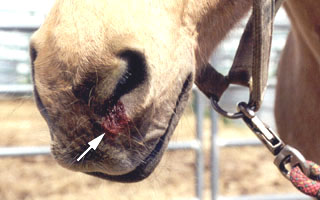
| This horse has some mild bleeding from the nose following a moderately strenuous workout. |
Introduction:
EIPH, as the name implies, is exercised induced bleeding from the lungs. It is very common in athletic horses of all breeds. Some reports indicate that as many as 75% of all race horses experience some type of EIPH after moderately strenuous exercise. Only horses that are worked at speeds display this problem. It is generally not seen in animals that perform strenuous labor (pulling competitions and draft work) without speed.Causative Agents: Exercise is the major cause for the bleeding. What actually happens in the lungs to cause the bleeding is less clear. Some studies indicate the small blood vessels in the lungs are damaged and/or disrupted because of elevated blood pressure during exercise. Some scientists believe the problem may be exacerbated by dust as well as by other respiratory diseases. The exact internal cause for the bleeding from the lungs is currently being researched.
Clinical Signs: The primary sign noted is bleeding in the respiratory tract. Occasionally, horses may bleed from the nose (epistaxis), but it is more common to observe this bleeding during an endoscopic exam of the airways. Some reports state that only 10% of horses with EIPH actually have any blood coming out of the nose. Additional signs that are often reported include coughing, abnormal breathing, lack of energy, and excessive swallowing. The coughing and swallowing can be due to blood in the airways, but can also be the result of material that is inhaled during exercise.
Diagnosis: As mentioned in the clinical signs section, less than 10% of true EIPH cases experience bleeding from the nose. Therefore, to accurately diagnose this problem, an endoscopic exam is often required (see page D200). An endoscopic exam is where a small, protected camera is placed in the respiratory tract. This camera allows the clinician to examine a horse’s respiratory tract from the end of the nose to the trachea and lungs. The endoscopic exam should be performed 30 to 120 minutes after racing. If, after exercise, any blood is noticed during the endoscopic exam, and the bleeding is not associated with other problems, the horse is diagnosed with EIPH. If no bleeding is noticed, yet there is still concern that the horse may have EIPH, a sample of the fluid in the lungs should be taken. This sample is examined under a microscope looking for macrophages (white blood cells) containing hemosiderin (iron pigment). If hemosiderin is present in the sample, blood has been present in the lungs, and the horse is considered to have EIPH.
Treatment:
The most common treatment/prevention is the use of the drug furosemide. Furosemide, a diuretic that causes bronchodilation (dilating of the airways), is thought to reduce the amount and severity of EIPH. However, many reports indicate that the use of furosemide only reduces the amount of blood in the respiratory tract of most horses, and that 50% of horses still experience significant EIPH.Prevention: Because the exact cause is unknown, it is difficult to recommend specific prevention measures. Some suggestions may include keeping/working the horse in dust free environments and providing routine vaccinations to prevent respiratory tract infections. See the vaccine recommendations on page A905. Some reports indicate the use of furosemide may increase performance in some horses.

|
|